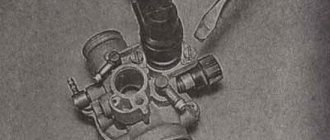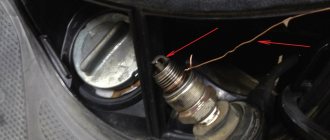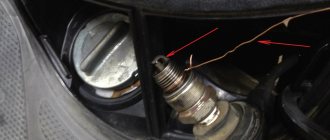Cars admin26.02.2020
After a long period of inactivity in a cool room, equipment may not always start as well. Therefore, owners often have the following question: how to start a scooter after winter so that it starts working immediately? In practice, a large number of methods have emerged that allow this to be done quickly and easily. Let’s make a reservation right away - if preliminary preparation took place before preservation, the 4-stroke engine will start instantly.
Scooter won't start
Doesn't spark appear on the wire?
In most cases, a Chinese scooter will not start due to a current leak, that is, a spark does not flow to the wire at all. Experts note that the reason usually lies in insulation, which is missing in a certain place, which leads to the bare part touching the body of the scooter or another place where all the current goes. You need to solve the problem with diagnostics; first of all, inspect the entire high-voltage wire in order to find a bare spot.
If the wiring is intact, the reason for the lack of current will be more serious. Current will not flow to the spark plug for the following reasons:
- broken switch;
- ignition sensor is broken;
- The ignition coil is faulty.
The three above parts are the main ones in generating and supplying current to the spark plug, so any damage to them threatens to prevent the 4t scooter from starting. But if there is a spark, but your scooter does not want to start, move on to the next step - checking the fuel system.
Checking the fuel system
It is gasoline that plays the most important role in whether the scooter will start or not, so sometimes certain factors affect the supply of fuel to the carburetor and the engine itself. Fuel can be supplied either insufficient or in too much quantity, which in any case affects the performance of the scooter. The process of diagnosing the fuel system begins with the gas tank; check the presence of gasoline, its supply, and whether the hole is clogged.
After checking all the fuel lines and the valve for operability, we proceed to diagnosing the carburetor
This is often the cause of improper fuel supply; it is important to keep the carburetor in a fully tuned state without any dirt or other debris. Clean the carburetor and blow out all its channels, you will also have to adjust all the jets
If your 4T scooter does not start after cleaning the carburetor, you are most likely getting too much fuel.
If an excess of fuel is detected, you will see that the spark plug is quickly flooded, this does not allow a spark to form. You can verify this after diagnosing the fuel pump. If you disconnect the fuel hose and start the scooter with the kickstarter, a uniform amount of gasoline should come out of the hose. If the fuel pump does not work, the flow of fuel is uneven and there is too much fuel, replace or clean the pump.
Other reasons
In general, there are many reasons why a 4t scooter is difficult to start; this may be due not only to the fuel system and ignition; experts also point out that sometimes the scooter does not work due to a damaged CPG or lack of compression. If there is no compression, the piston will not create the necessary pressure to start the engine. In some cases, simply replacing the rings on the piston helps; in more advanced cases, you will have to replace the entire CPG.
Cleaning and adjusting the carburetor
If you don't know why the scooter stalls when you give it gas, first check and adjust the carburetor. If it was often removed and adjusted, it may be that somewhere it began to leak air. If such a problem occurs, you can use a sealant or buy gaskets for the carburetor.
Let’s say the scooter stalls, you don’t know what to do. Then the first thing we do is clean the carburetor. Mostly the jets and auxiliary systems become clogged with dirt, so after cleaning the carburetor and adjusting all the jets, you can try to start the scooter again and give it gas. If the problem is not solved, move on to the main action - adjusting the needle to adjust the quality of the mixture. The needle in the carburetor performs the main task - adjusting the amount of fuel that is then supplied to the combustion chamber. Basically, you can adjust the quality of the mixture using a special jet on the carburetor, but if working with it does not produce results, you will have to manipulate the needle.
The needle is in close contact with the throttle handle, so when the handle is opened, the needle rises up and allows fuel to be supplied. That is, the higher the needle is raised, the more gasoline flows in and the power increases. Power guarantees better speed and traction. If you disassembled the carburetor, taking out the needle you will see 5 grooves on it, one of which has a retaining ring installed. Typically, such a ring is located in the center, that is, on the 3rd groove. If you lift the locking ring up, the needle will drop lower. This allows a leaner mixture to be supplied to the evaporation system, in which more air is supplied than gasoline. When installing the ring on the 4th and 5th grooves, the mixture becomes richer, where more gasoline is supplied than air.
The moped won't start, what should I do?
How to start a scooter without a key
When purchasing a moped, a novice motorcycle enthusiast least of all thinks about the rules of its operation, preventive maintenance and subsequent repairs. The result of this is faster wear of parts, constant breakdowns and unstable operation of the vehicle as a whole.
During the first time the moped is used, problems with the power unit and chassis may not be noticeable, but with each new day the likelihood of unexpected failure increases significantly. Very often, novice bikers, due to insufficient experience and frivolity, do not react to minor malfunctions in the operation of the vehicle and “rape” their two-wheeled friend until it stalls completely.
It is at this moment that a question arises that cannot be ignored. What to do if the moped does not start from the starter? There are a huge variety of both minor failures and serious breakdowns that can lead to a similar result.
Serious ones, of course, require the intervention of qualified motorcycle mechanics, while minor causative defects can be eliminated even by a novice. The latter can be grouped by similarity and solution methods.
- Problems with the electrical system
The symptoms are quite simple: the moped will not start from the starter. To make sure of this, you need to turn on the turn signal in “ON” mode. If it does not work, the reason is a power failure. First of all, you need to check the battery terminals and the integrity of the wiring system as a whole. If everything is in order, measure the battery charge level. It should be around 13 volts.
Insufficient fuel supply level
It manifests itself in the fact that the moped stalls. To eliminate this, it is necessary to increase the fuel supply (by adjusting the suction). Alternatively, you can change the amount of mixture supplied to the carburetor. To do this, you need to find a small bolt on it and use a screwdriver to calibrate it.
External symptoms are similar - the moped starts and stalls. In road conditions, you can try cleaning the supply hoses using the blowing method using a pump. If the procedure does not help the patient, you will have to resort to a full cleaning of the carburetor.
Air filter clogged
To diagnose, you need to remove the cover and inspect the filter element. As a rule, foam rubber plays its role. Even a cursory inspection is enough to understand that the filter is not functioning properly. It is usually soaked in oil or crumbles when touched. In this case, the filter element must be replaced with a similar one with exact dimensions.
The spark plug is not functioning properly
One of the reasons why a moped will not start may be a malfunction of the spark plug. In order to make sure of this, you need to carefully examine the candle and the space under it. It should be dry, if not, wipe it.
To check the functionality of the candle, you need to put a cap on it and touch the bottom part to the frame. After that, try to start the moped using the kickstarter. If a spark jumps, the contacts inside the cap are probably not in order.
The fuel pump is clogged or faulty
Most mopeds do not start because debris has gotten into the fuel pump or supply pipes. To diagnose and solve the problem, you need to remove the tube that supplies fuel from the gas tank. Next you need to blow it out. After this, drain all gasoline from the tank and refill it with another.
There is a possibility that the fuel pump itself is faulty. In order to verify this, you need to remove the two remaining tubes and blow out the lower hole. If after this no fuel comes out of the top tube, then the problem is the serviceability of the fuel pump.
The moped muffler is faulty
The moped may start and suddenly stall due to improper operation of the muffler. To diagnose the problem, you need to put your hand on the exhaust gas outlet with the engine running. If it doesn’t hit your hand, then the muffler is simply clogged. To eliminate the malfunction, you should contact a service station.
Spring delights
General recommendations for scooter maintenance Proper running-in of the scooter Adjusting the scooter valve clearances Centrifugal clutch - removing, installing, replacing pads Is the flying season over? It's time to think about preserving your scooter Spring delights or How to start a scooter after winter Instructions on changing the engine oil of a scooter Instructions on changing the transmission oil of a scooter Instructions on cleaning the air filter of a scooter Checking and replacing a scooter's variator belt Replacing a scooter's variator belt without disassembling the variator Scooter tires Maintenance of cables, locks and other scooter mechanisms Replacement of wheel bearings and brake disc Repair and maintenance of chain scooter transmission
Typical reasons
1kz-te knocks after
Starting a scooter in cold weather may not always be possible due to various factors. First of all, you shouldn’t torture the equipment if it doesn’t start right away. Check the following:
- Battery condition. If its charge is less than 12 A, the starter will not work. The normal voltage should be 14.5, this can be checked using a voltmeter. Try kickstarting the scooter.
- No spark. If the scooter was working fine, but then stopped starting, you should check to see if there is a spark. To do this, you need to pull out the spark plug and check its condition. The problem could also be with the coil or switch.
- The equipment may not be satisfied with the quality of gasoline.
- The malfunction may be hidden in the power system. If the scooter has trouble starting when cold, try adjusting the carburetor.
Malfunctions in the power system
The power system may be to blame; If the piston group of the engine is working properly, then you should check whether gasoline enters the combustion chamber or not. This is easy to check: unscrew the spark plug and inspect it; if it is wet, it means gasoline is flowing. If it’s dry, we start checking with the gas tank: first, you need to find out if there is gasoline in there. If there is, check whether the tap is open. If everything is open, you need to remove the vacuum hose and clean it with air.
If everything is in order, move on to the carburetor float chamber. The bottom of the device is removed; it is usually held on by bolts. It contains a float. If the chamber is full, but gasoline does not flow to the cylinder, the nozzle is most likely clogged. You will need to pull out the needle, remove debris, dust, and all foreign particles. You can also check the scooter's petal valve: it is located below the carburetor. The petals may be damaged, causing the scooter to not start even if it is new. If the petals are not closed tightly enough, the valve must be replaced. In some cases, you can bend the petals with your fingers, but this measure will only help for a short time - only to start the scooter several times and ride it for parts.
In case of serious damage, you should check the piston, whether it gives the required compression ratio, the seals of the piston system, the CPG and the ignition system. But these reasons are more likely characteristic of old equipment that was not properly cared for.
No spark in spark plug
First of all, you should check the spark plugs if the moped does not want to start.
- The spark plug needs to be unscrewed. You can check it using a special device that is sold in car dealerships; it's inexpensive. You can inspect the candle visually. It should not be black or damaged.
- If the candle is wet, it needs to be dried. This should not be done with open fire.
- The candle may be stained with oil and carbon deposits may be visible on it. All this is cleaned with metal brushes, similar to toothbrushes.
- An easy way to check if there is a spark is by unscrewing the spark plug, putting the wire on it leading to the ignition coil and placing it on the cylinder. If you turn the starter, you will see a spark. If the spark plug is working but there is no spark, the problem is in the ignition coil.
Attention! The procedure must be carried out carefully, without touching the scooter frame or other metal objects with your bare hands, otherwise you will get an electric shock. If there is a spark and its color is yellow, then you need to install a new spark plug; yours is no longer suitable for use. A normal spark is blue and flows continuously
A normal spark is blue and flows continuously
If there is a spark and its color is yellow, then you need to install a new spark plug; yours is no longer suitable for use. A normal spark is blue and flows continuously.
If the coil is new, as are the spark plugs, but there is no spark, it is still worth checking the following:
- Oxidation of electrical wire contacts. They will need to be cleaned; for example, the wires going to the battery often become oxidized.
- No spark on the wire. This means that somewhere there is a bare wire that touches an ungrounded metal part, because of this the spark does not appear, since the current does not reach the coil. Check the wiring.
- The switch may also fail. This is an inexpensive item that it doesn’t hurt to always have in reserve.
Checking Basic Systems
In order to understand why the scooter does not start, the problem must be looked for sequentially:
- Start with the simplest thing - check the battery charge, if it is normal, proceed further.
- Check if the scooter has gas; it’s easy to forget to fill up.
- See if gasoline is flowing into the carburetor.
- Unscrew the spark plug, inspect it and check if there is a spark.
- If the spark plug is in order, check the coil in the manner described above, turning the starter with the spark plug removed.
- We check the coil and wiring with a multimeter, there may be a break.
- Clean the carburetor and adjust it correctly.
Supply system
After checking the electrics and making sure that everything is in order, you should get to the power system: if the fuel is supplied in the wrong amount, the scooter may not start. If there is a large amount of fuel, the carburetor overflows and the spark plug becomes wet, and if there is little fuel, there is not enough of it for the piston to move. To do this, you need to adjust the jet, floats and needle, moving the limiter on it. It wouldn't hurt to check the gasoline pump either: sometimes it simply fails, so the fuel doesn't go anywhere.
Ignition system
The entire ignition system must be checked if there was a spark and then disappeared. If the spark plug and coil are normal, but there is still no spark, you will have to check more thoroughly. The coil, generator winding, and switch come under suspicion. A multimeter can check all this: for example, they test a generator like this - one probe is connected to the engine crankcase, the second to the generator sensor.
The resistance of a working sensor is 500 Ohms. If the value is higher, the winding is faulty; if it is below 200 Ohms, the problem is in the coil.
How to restore starting from the starter
How to start a car with a pushrod
The moped does not start well from the starter, however, doing it from the foot is simple and easy. If the engine does not start well from the starter, you must first check the fuse located in the battery compartment.
The location of the fuse on the battery is marked with an arrow.
Due to the often poor quality of the manufacture of the fuses, and, consequently, the entire starter, the wire located inside the starter glass bulb can barely touch the contact caps, which is why the fuse contact becomes unsuitable. After the low-quality fuse has been replaced, the moped can be started using the starter.
Useful tips
If the brake discs are stained with oil during operation, they must be treated with alcohol. After all procedures, check the functionality of the mechanism. If it starts to “peck” - air pockets appear - there is not enough oil. When there was strong kickback, too much oil was poured onto the steering wheel. Be sure to pay attention to the condition of the plug. Here is a list of fork maintenance: smudges - inspection of oil seals and anthers; incorrect operation - checking the spring and mechanism geometry; simple – complete revision; Suitable mileage - mandatory flushing and oil change.
Flushing is best done with low-viscosity oil. Despite the fact that the seals are able to withstand the effects of kerosene and other flushing liquids, they still become tanned and fail faster.
Reasons why the scooter does not start when cold
:is::is::is::is: killed. I won’t say anything further. I’ll just ask a question - uncle, how old are you? and then what the HELL they say to check the compression not hot, not cold! and then when the engine is slightly warmed up. - I’ll answer.
It’s nice when the engine of a four-stroke scooter works “like a clock” and does not cause any trouble to its owner. But basically this only happens when the unit is warm. As soon as the two-wheeled “minibike” sits in the cold for a while, that’s it – there’s no way to start it when it’s cold. And you can't make it purr either from the starter or using the foot. So why does it happen that a four-stroke scooter does not start? The most common problems are in the ignition and fuel supply systems. More on this below.
Diagnosing a candle
The first step is to conduct a visual inspection of the spark plug. Unscrew it and look carefully to see if there are any mechanical damages or defects associated with melting. If any of this is present, then the spark plug should be replaced. In addition, moisture could get on it. To verify this, you need to remove the ignition element from the cap and let it dry. You can even do this over a gas one.
Quite often you can see cases when the owner is faced with the following problem: the scooter will not start. This may be due to a large number of reasons. Most often these are typical breakdowns or malfunctions, especially if the moped was parked in cold weather. Depending on the identified problem, the moped can be repaired in a few minutes or several hours.
Typical reasons
First of all, you need to check: the ignition and power systems. Carry out a check in those places that can cause the moped to move. The reasons why the scooter does not start, especially in cold weather, may be the following:
No spark in spark plug
The scooter does not start because there is no spark in the spark plug. In this case, you need to do the following: the spark plug is unscrewed and checked for suitability. Connects to the ignition coil using a wire.
Changing the oil of a standard telescopic fork
The general oil change scheme is very simple: unscrew the drain plugs, wait until the oil drains, rinse the fork with kerosene if necessary, and then fill in new oil and put the plugs in place. But alas, practice shows that this procedure primarily depends on the design of the feathers. If the stay has a lower drain bolt, then the front chassis can be serviced without disassembly, but if the fork is of an inverted design or does not have lower drain holes, then you will have to completely disassemble the front suspension structure. Based on this, we divide the oil change process into two types:
Incomplete disassembly of the front suspension: The case is suitable for stays with an end lower or side lower drain bolt. With proper skill, you don’t have to disassemble the suspension at all, but there is always a risk of getting the brake mechanism or wheel dirty with oil, and then you’ll have to do extra cleaning work. It is best to make the replacement as follows: First of all, we clamp the front brake or rest the wheel against the wall, sit on the motorcycle and with the weight of our body force the fork to work 10 - 15 times, this is necessary to warm up the oil, raise sediment and better clean the mechanism. We place the motorcycle on the main stand so that the front wheel is hanging in the air. Remove the front wheel and free access to the upper oil drain bolts from the feathers (the end part of the feather). Using a suitable spanner, unscrew the upper drain bolts (in some cases it may be necessary to loosen the upper clamps). Place a container to collect the oil under the lower drain bolt. Using a spanner wrench, unscrew the bolt and wait until the oil is completely drained. If necessary, rinse the fork with kerosene. We inspect the anthers and seals, replacing them if necessary.
Why is there no spark
The second most common problem is why the scooter won’t start - there is nothing to ignite the fuel, or there is a spark - but there is nothing to ignite. To check the spark, you need to remove the spark plug cap and unscrew the spark plug. It must be dry and clean. The gap between the electrodes is needed 0.6-0.7 mm. The first sign of a lack of spark is that the spark plug is wet and smells of gasoline. This means the fuel did not burn in the cylinder and remained on the spark plug. Dry and clean it, then insert it into the cap and lean it against the cylinder mass.
At the same time, press the starter button for a second or the kick starter a couple of times. The spark between the spark plug electrodes should be clearly visible. If there is no spark, then replace the spark plug with a new one, most often this is the problem.
You may be interested in how to adjust the ignition on Ural motorcycles or install electronic ignition on Izh Jupiter 5 yourself.
The quality of gasoline in Russia is not very good, this quickly kills spark plugs, especially iridium ones. If a spark does not appear with the new spark plug, we look for a fault in the wiring. A broken wire or oxidation connecting the ground between the frame and the engine is a common problem. Another reason could be a burnt-out resistor in the spark plug cap. It can be checked with a multimeter; the resistance should be about 5 kOhm. If this is not the problem, then check the ignition coil, this can also be done with a multimeter. In this case, the resistance of the primary and secondary windings is checked. The resistance of the primary winding, as a rule, tends to zero. Well, the resistance of the secondary should be several kOhms. There shouldn't be a break.
It is also worth checking the switch by replacing it with a known good one.
The next possible malfunction is a break in the wire coming from the ignition switch or the wire coming from the switch. Check the wires for breaks or abrasions. Check the reliability of the female-male plug connections. If no visible damage is found, a wire break can be detected by testing each wire with a multimeter. If the above manipulations did not produce results and a spark never appeared, the last reason for its absence is failure of the generator, pulse sensor or generator windings, which happens extremely rarely. The generator windings can also be checked with a multimeter.
Accumulator battery
Never turn the starter with the battery until the crankshaft completely stops turning. When the power unit refuses to start instantly, there is no need to try to turn the starter again “waiting for a miracle,” since the charge in the batteries will still come in handy.
For trouble-free starting, you should only use a battery that is in good technical condition. A battery lit through wires may give good results, but it will not provide a reliable start, as when using a battery prepared in advance for a scooter. If the battery has suffered from self-discharge, it will not only not be able to crank the engine, but will also not be able to provide the required voltage to the “brains” (if they are present).
A cold moped scooter engine does not start, looking for the reason
You can often encounter a situation where a warm scooter engine works fine, but when it’s cold, problems arise and starting it becomes extremely difficult, and in some cases, impossible. In this case, you will not be able to start the scooter using either an electric starter or a kickstarter. In this case, the problem usually lies in the ignition system or in the power system. Both breakdowns require serious attention and adherence to clear instructions, which I will describe below. Since most often the problem lies in the ignition system, let’s consider this point in more detail. After that, let's move on to the power system.
The scooter does not start due to problems in the ignition system. To begin with, we unscrew the spark plug and examine the electrodes; if they are melted or have any defects, we replace the spark plug with a new one. If the spark plug is wet, be sure to remove it from the cap and dry it, for example, I do this on a gas stove. Now we insert it back into the cap and check for the presence of a spark. How to check for a spark on a scooter, the scooter will not start due to problems with the spark plugs. To do this, you need to attach the spark plug to an unpainted part of the engine, usually to the cylinder, and crank the crankshaft using an electric starter or kick. Before doing this, do not forget to turn on the ignition of the scooter. You should not check the spark with your bare hands; you should definitely protect yourself with special thick rubber gloves or a piece of rubber. Another point to consider is that the spark plug must be kept away from the spark plug hole in the cylinder head, since gasoline can splash out from there and ignite. In my practice, this has not happened, but the recommendations should not be neglected. When the crankshaft is turned sharply, a blue spark should run through the spark plug, quite powerful and constant. If there is no spark, or it is yellow and appears occasionally, first of all, we take it as faulty and check the spark in the same way on a new spark plug. As a rule, in more than half of the cases, at this stage the problem is solved and the scooter works properly
That is why it is so important to always have a working spare spark plug with you, which will always save you on the road in such a situation. If, after you have installed a new spark plug, the problem remains, we look further for a known faulty place: The scooter does not start due to a faulty spark plug cap or connection with it
It also happens that the cap may not be in sufficiently tight contact with the high-voltage wire. To exclude this from the possible causes of the malfunction, we must check it. Unscrew the cap from the wire and bring the wire 2-3 mm to the metal part of the engine
Please note that if, in the case of a spark plug, we pressed it against the engine, then in this case the specified distance must be maintained. Rotate the crankshaft and pay attention to the end of the wire, a spark should jump between it and the engine (do not forget that we are doing all this with the ignition on). If the spark appears, you can breathe a sigh of relief
We examine the spark plug cap, if it is wet (and often because of this the normal spark disappears), then we dry it with a hairdryer, replace the spark plug and check the spark. No changes? Then we replace the cap with a new one and go. Now consider the option in which there is no spark even on the wire. This phenomenon can happen with the so-called current leakage. The essence of this phenomenon is that any exposed section of the high-voltage wire touches the metal part of the scooter. This may not happen directly, and the role of a conductor can be played by water, which accumulates in the area of the bare area when driving through puddles. Look carefully at the wire running from the spark plug to the ignition coil; if you do not find any places of disconnection or damage, then you can assume more serious breakdowns in the ignition system, namely: the ignition coil has failed; the ignition sensor (hall sensor) has failed; the switch is faulty; Any of these elements, if faulty, can cause a lack of spark or unstable operation of the scooter engine
You shouldn’t buy them right away; it’s important to determine which electrical appliance is faulty. To do this, for example, you can borrow exactly the same one from a friend to check
The scooter does not start due to problems in the power system.
Battery
There is no need to turn the battery with the starter until it completely fails to turn the crankshaft. If the engine refuses to start right away, there is no reason to force it, and you will still need the power in the battery.
The condition of the battery is considered an important condition for trouble-free starting if there is no kickstarter (relevant for progressive scooters with large cubic capacity). A battery “lighted” through the wires will help, but will not give the same result as a well-charged scooter battery in advance. Not to mention the fact that a self-discharged battery over the winter will not crank the engine, it will also not provide suitable voltage to the “brains” (if any), which, because of this, will categorically refuse to work correctly and give a spark.
Let me remind you that it is preferable to charge the battery with a current of 10% of the rated capacity for 10 hours, i.e. It is better to charge a battery with a capacity of 9 A/h with a current of 0.9 A for 10 hours. The appropriate charging current is marked on the battery cover.
Motorcycle won't start
What could this be and what should I do? Our advice:
FIRST. Pay attention to whether the starter works when you press the button. If it turns slowly and the lights on the dashboard go out, then most likely your battery is simply dead, look for an option to charge it
If it turns slowly and the lights on the dashboard go out, then most likely your battery is simply dead, look for an option to charge it.
If there are zero such options, try to jump start the motorcycle (read about this below) in order to get to the nearest motorcycle/car repair shop to find out the cause of the malfunction or at least to recharge the battery.
SECOND. The starter doesn't turn at all.
There may be three options:
- The side stand is up and the bike is in gear. It happens to everyone) Remove the bandwagon!
- The battery has reached zero - charge the battery.
- There is a problem with the starter or fuse. The solution is either calling a mechanic, or a motorcycle tow truck to a motorcycle service center, or.
THIRD. The starter is operating normally.
We check the fuel valve; if it is suddenly closed, open it.
And, just in case, again it happens to everyone, we look to see if there is gasoline in the tank.
FOURTH. If everything is in order with this, then we look at the spark plugs.
Unscrew the spark plugs. Are they damp and smell like gasoline? This means they are flooded. This can be for two reasons - you filled them or there is a malfunction in the motorcycle.
If you did this, for example, you turned off or started the motorcycle incorrectly, then you can fix it as follows.
Dry the spark plugs, blow them out and heat them. !We do not clean with a wire brush!
Next, put the dry spark plugs in place and try to start the motorcycle. If the motorcycle works, then !hurray! we continue our way.
TIP: purchase and carry a spare set of candles with you; once filled candles can stop working at any time, even if you bought them just yesterday.
If after the above steps the motorcycle does not start, then there is a clear malfunction either in the presence of a spark or in the fuel supply. You will have to take the motorcycle to a specialist motorcycle service center.
The candles are fine, they are dry.
FIFTH. Checking the fuel supply.
Remove the fuel supply hose from the carburetor/injector.
Carefully! There must be gasoline in the hose, and it may be under pressure. If there is no gasoline there, then the problem is most likely in the fuel pump or fuel tap.
If there is no gasoline there, then the problem is most likely in the fuel pump or fuel tap.
And if you can try to solve the problem with the faucet yourself (rinse, blow out, clean), then it is better to entrust the problem with the gas pumps to specialists, so as not to make things worse.
All these actions led to nothing?
Preparation
No matter how complicated the oil change process you choose, it can be speeded up if you have the right preparation. First of all, wash the front fork from adhering dirt and oil. Next, prepare a container for creaming the lubricant to avoid messing up your garage. If the fork is not high enough on the footrest, you can prepare small spacers for the footrest. Finally, you should prepare the tools:
- set of open-end and ring wrenches
- mallet
- kerosene
- funnel
Messages [1 to 20 of 34]
1↑ Topic from Uralchik 09/27/2014 18:27:13
- Uralchik
- Newbie
- Inactive
- Registered: 01-06-2014
- Posts: 22
Topic: It's corny, but Ural won't start
Guys, the story is this: I started it, rode about 500 meters and the motorcycle stopped pulling itself (in a straight line), started shooting and sneezing. Well, you understand. Immediately thinking - sucking air. And sure enough, oil was oozing under the left cylinder head. There was an aluminum gasket, I replaced it with a paronite gasket. I set the valve clearances “by eye”, first setting them to TDC (arrow on the flywheel) and adjusting the left one, and then turning the right cylinder back to TDC. I haven’t come across tuning on two-cylinder ones, so I asked my friends how it was done, and then began to demonstrate. It seems that everything is set as before (the gaps feel the same), but the bastard won’t start! Once it grabbed once, roared at high speeds (for some reason, at high speeds) for about five seconds and died. It never started again, didn't even catch. The spark is excellent on both spark plugs, I didn’t touch the carburetors and ignition, as before the breakdown they were still standing, but before the breakdown the engine was flying, not driving
Tell me where to start poking around to understand what's going on?
Oh, I almost forgot to clarify, the battery is fresh, just from charging, unless the motorcycle was parked in the open air, where did the water get in?
Edited by Uralchik (27-09-2014 18:28:06)
2↑ Reply from RaaF37rus 09/27/2014 19:22:37
- RaaF37rus
- Pro
- Inactive
- Name: Sergey
- From: Ivanovo region. Kamenka village
- Registered: 07/27/2013
- Posts: 568
- Reputation: 66
- Motorcycle: IMZ 8-103-10
Re: It’s corny, but the Ural won’t start
Well, it’s better to set the valves not according to the mark on the flywheel, but “when the intake starts to close, you adjust the exhaust, and when the exhaust starts to open, you adjust the intake.” Couldn’t you turn the camshaft? look.
3↑ Reply from Lerych 09/27/2014 19:47:12
- lerich
- MotoDealer
- Inactive
- Name: Valery
- From: Yaroslavl region
- Registered: 01/18/2012
- Posts: 2,138
- Reputation: 215
- Motorcycle: Ural m66, Riga 22, Java 360, Ural 8.103
Re: It’s corny, but the Ural won’t start
so there could be a bunch of reasons. I didn’t touch the carburetors, but gasoline may not flow. from the same tank for example. I have about the same crap. it started and worked well, and then suddenly it won’t pull after 5 km. I took the carbs apart and gasped! there the dampers are not just worn out, but they are even chewed up, just on the cylinder, which barely plows. The tank was so clogged that I had to pierce the nipples that connect the compartments with a nail. The ignition tends to unscrew. The camshaft support has the same property, but the marks no longer match and the valve timing shifts. The valves are somehow strangely adjusted. As I understand it, if you set it according to the mark, then one cylinder and the second should be set at 180 degrees, and not according to the mark. Otherwise, all strokes will occur on both cylinders at the same moment, and this should not be the case.
- From: Permyak
- Registered: 05/16/2012
- Posts: 6,924
- Reputation: 618
- Motorcycle: Dnepr MT 10-36, Ural M 67
The motor belt is damaged
The scooter does not start - there is a spark, there is gas, but there is no reaction.
Another source of the problem may lie in a deformed belt in the motor design. This technical element makes a huge number of revolutions during the day. It is located on the same side as the kick starter, under the motor cover. The belt itself is a consumable, replaceable element of scooters, so sooner or later it will need to be replaced. It cannot be restored; all you have to do is buy a new one at a motorcycle parts store. When purchasing this spare part, it is recommended to pay attention to the overall diameter of the belt and the thickness of the rubber layer - they must correspond to the model of the scooter and its configuration. Otherwise it will not work on your moped










